FilesAnywhere Review
FilesAnywhere is a decent EFSS provider that doesn't quite offer what its competitors do. While it gets its sharing and syncing right, its interface feels ancient and the cheapest plan is severely lacking. Read our full FilesAnywhere review for the details.
FilesAnywhere has been providing online backup, cloud storage and cloud user management since the turn of the century. Time brings wisdom and sometimes complacency, and this business cloud storage provider shows both. In this FilesAnywhere review, we’re going to explore where the service excels and where it doesn’t.
On the one hand, it complies with the latest in security, but on the other, it can’t be bothered to even update its interface. The price is solid, as long as you’re willing to give up some storage space and security, and the sharing functionality is excellent. However, FilesAnywhere still falls behind elsewhere.
Key Takeaways:
- FilesAnywhere provides excellent user management and sharing features.
- Third-party integrations are light, but FilesAnywhere still has support for Office 365, G Suite, WordPress and Zoho.
- The price of the Business Starter tier is good, but with limited storage and no encryption, it’s basically a non-option.
- The web interface and general user experience are bad by the standards of a decade ago and worse by the standards of today.
Compared to the best business cloud storage, there are better options on the market (like pCloud, which you can see in action in our pCloud review). However, FilesAnywhere still provides online storage and does so at a low price.
-
12/08/2023
Updated to include info on MEGA.nz’s domain change to MEGA.io.
Strengths & Weaknesses
Pros:
- Excellent user management
- Solid security features
- Free backup storage
- Fast email support
Cons:
- Limited storage space
- Limited security on certain tiers
- Outdated web interface
Alternatives for FilesAnywhere
- 1
- :
- : 100 GB
- :
- :
- :
- :
- 3
- :
- : Unlimited GB
- :
- :
- :
- :
- 4
- :
- : 50 GB
- :
- :
- :
- :
- 5
- :
- : Unlimited GB
- :
- :
- :
- :
Features
FilesAnywhere comes with a few unique offerings, including no file size limit, file tracking and point-in-time data restore. Even better, these features are available across plans. It also has a list of third-party integrations, though it’s not nearly as robust as Box (read our Box review).
10,000+ Trust Our Free Cloud Storage Tips. Join Today!
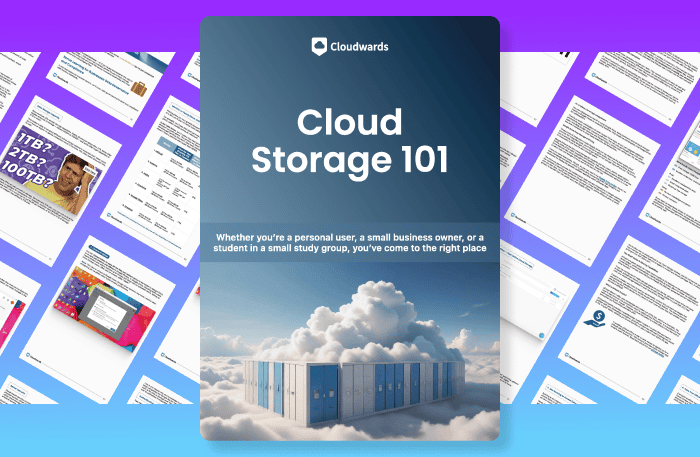
- Demystify cloud storage terminology and key concepts in plain language
- Discover easy-to-implement techniques to securely backup and sync your data across devices
- Learn money-saving strategies to optimize your cloud storage costs and usage
For document editing, there’s support for Office 365, G Suite, WordPress and Zoho — these are four of the six total integrations FilesAnywhere supports. In addition, you can use Adobe Sign and Autodesk Freewheel. If you use WordPress, FilesAnywhere has a plugin that lets you create a new blog post entry with files from the cloud. You can also backup your tweets using an add-on.
Surprisingly, FilesAnywhere has more support for single sign-on services (SSO) than it does other integrations. It even supports larger SSO services, including OneLogin (read our OneLogin review).
Productivity Tools
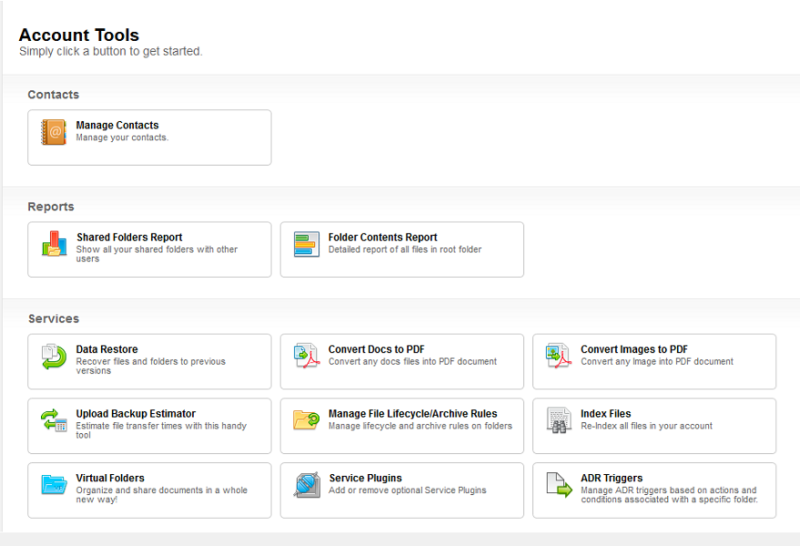
FilesAnywhere also has tools that can help you increase your productivity. These include previewing your files in various groups and converting images and documents to PDF. If you need to pull up specific files quickly, you can use virtual folders to create folders that contain frequently used files.
In a similar fashion, you can automate your processes by creating a workflow. Workflows enable you to automate repetitive tasks and the sharing of information between users, which saves you time.
For those who need to gather feedback from users, the “eforms” feature will be valuable. Eforms let you create and share a custom form, as well as view forms reports.
FilesAnywhere also has online backup, which is a rare feature among EFSS services. It provides a wealth of options, including creating backup profiles and using a scheduler for online backup. You can backup your files using FTP, SFTP and WebDAV protocols. If you’re not familiar with them, read our separate what is FTP and what is WebDAV guides.
However, it’s not easy or straightforward to use, and if you want such an online backup provider, our best business backup list will give you some ideas.
Sharing Files With Other Users
FilesAnywhere has powerful file sharing options, which include generating sharing links, picture links, folder sharing and virtual folder sharing. There’s also a page that details your shares so that you don’t have to manually check which content you’ve shared with others. You can also generate a report detailing your shares and share data using the desktop client.
You can share files and folders using either the web or the desktop client. The web client lets you share folders and files by right-clicking an object and selecting “share” or by creating a share from the “share” view.
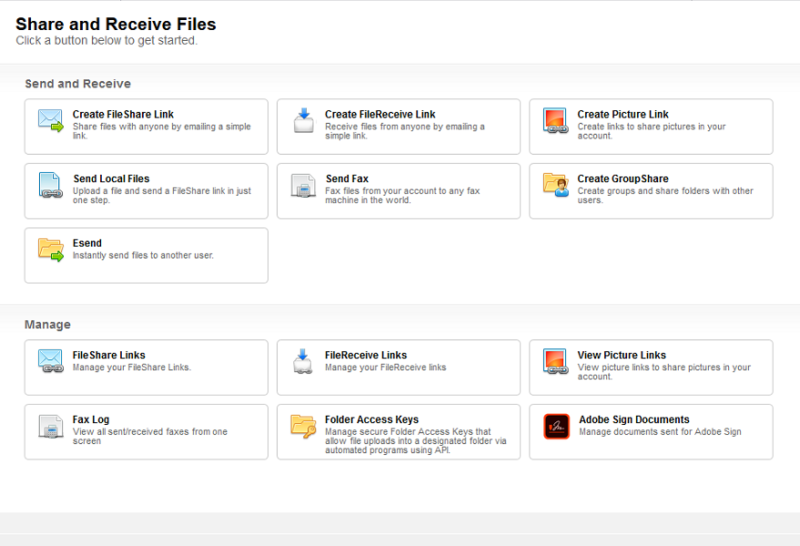
Sharing Links & Folders
If you want to share files or folders, you need to generate a link. You can protect the link with a password, set it to expire after a certain period, enable or disable a download, specify a download limit and get notified when the link is accessed or used for download. Plus, you can create a custom page to go with your link. You can copy and paste the link or send it via email.
There’s also a special “picture link” you can create if you want to share photos from your account. In addition, you can request others to send you files, upload a file and share it in one go, send files directly to users and even fax files (for users who are nostalgic about the ‘90s).
If you want to share files from various folders, you can do that using virtual folders. First, you’ll need to create a virtual folder from the “tools” menu of the web client. Next, you can add subfolders and link to files in any way you wish. Once you’re finished, you can share the folder as a link, as a group share or send it as a picture link.
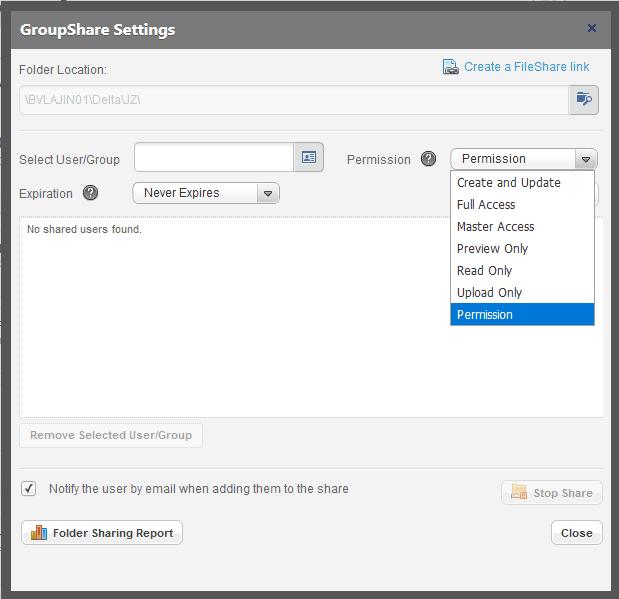
You can share folders, too. To do it, you need to select a user or a group you want to share with and assign a level of permission. You can also share files and folders as links using the desktop client. After you generate a link, you can send it, email it via Microsoft Outlook or copy and paste it.
FilesAnywhere supplies pages that show your various shared links and let you generate a report that details shared folders.
It uses the classic model of sync to transfer your files to cloud storage and your connected devices but doesn’t achieve the best upload speeds. That said, it provides the selective sync feature and uploads after the first benefit from the block-level sync algorithm.
Syncing Speed & Management
FilesAnywhere uses a sync folder to mirror your files to the cloud and vice versa. You can choose where you want to put your sync folder, which isn’t something that most EFSS services offer. If you need to save storage space, FilesAnywhere provides a selective sync option, which lets you choose what files you want to sync to your desktop.
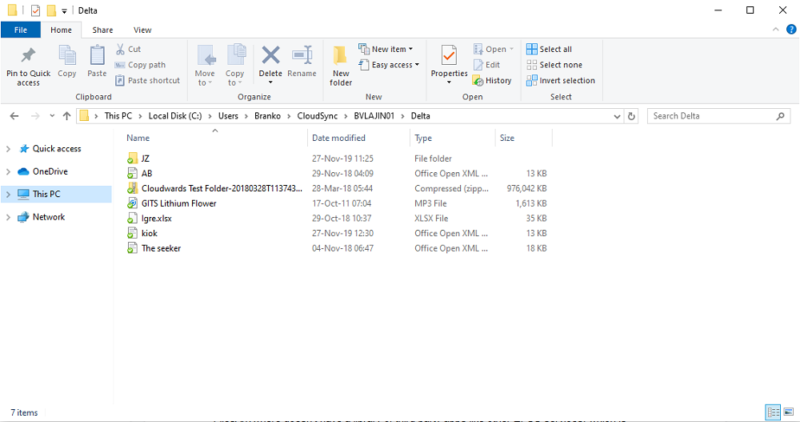
You can also resync files and folders, if the sync folders start giving you issues. That didn’t happen when we synced our 1GB zipped test folder, though. The upload finished in 41 minutes and 55 seconds, which is 10 minutes slower than we expected. It’s not a bad result, but it’s not great either.
That said, FilesAnywhere uses block-level sync to speed up the transfer of already uploaded files. It does that by transferring only the parts of the files that have changed, rather than the entire file. That puts it in the rare company of EFFS services that use block-level sync.
We would like to see an option to install a network drive, though, which would enable you to access files from the cloud without downloading them.
FilesAnywhere Features Overview
| Features | |
|---|---|
| Sync Folder | |
| Block-Level Sync | |
| Selective Sync | |
| Bandwidth Throttling | |
| Sync Any Folder | |
| Max File Size | Unlimited GB |
| Network Drive | |
| File Link Sharing | |
| Link Passwords | |
| Link Expiry Dates | |
| Folder Sharing | |
| Folder Permissions | |
| Link Download Limits | |
| Upload Links | |
| User Groups | |
| Set User Roles | |
| Monitor User Activity | |
| Restrict User Storage | |
| Remote Device Wipe | |
| File Previews | |
| Edit Files | |
| In-App Collaboration | |
| Office Integrations | |
| Notes App | |
| Media Playback | |
| Mobile Apps | |
| Deleted File Retention | |
| Versioning | |
| WebDAV | |
| At-Rest Encryption | |
| In-Transit Encryption | |
| Two-Factor Authentication | |
| Client-Side Encryption | |
| Data Residency | |
| SSO Integration | |
| Custom Password Requirements | |
| 24/7 Support | |
| Live Chat Support | |
| Telephone Support | |
| Email Support | |
| User Forum | |
| Knowledgebase | |
| Free Plan |
Pricing
We like FilesAnywhere’s prices, but the storage size leaves a bit to be desired. The plans don’t offer much storage, but that might be enough for some businesses. However, other services offer much more for a slightly higher price. FilesAnywhere has three plans: Business Starter, Professional and On Premise.
- Price includes 2 users per month. Users: 2-5 Storage: 100GB Price per user
- 100GB
- Price includes 4 users. Storage: 2TB Users: 4-100 Price per user
- 3TB
- Unlimited GB
Business Starter Plan
The first and cheapest option, Business Starter, requires that you have two to five users, and $13.98 for two users billed monthly. It offers 100GB of storage, which you can increase up to 1TB of storage. It also offers unlimited file sizes for documents or whatever else you want and some standard EFSS perks like file versioning, API access and plug-ins.
Those features simply aren’t enough. Although Business Starter plays the role of a standard cloud storage plan, it lacks even the most basic security features. For around $5 per user per month, it lacks SSL/TLS encryption for data in transit as well as at-rest encryption.
To be clear, Business Starter doesn’t encrypt your files.
That’s ignoring the other missing features, such as the complete lack of user or group management and the Outlook add-on. However, the most frustrating part about this tier is that it’s really not that cheap. For example, Sync.com comes with 10 times the storage space and an actual list of features for $6 per user per month (minimum three users which makes it $18 per month in its annual plan), as you can see in our Sync.com for Teams review.
Locking staple functionality behind a more expensive plan is something almost no other EFSS provider does. For a bit more, you can subscribe to OneDrive’s most inexpensive tier, which gets you 1TB of storage per user for $8.33 per user per month with an annual commitment, and it starts with a single user. You can read more about that in our OneDrive for Business review.
FilesAnywhere Professional
The Professional plan provides 2TB of storage, which you can increase to 5TB of storage. The plan also requires you to have a minimum of four users without a maximum. It’s $47.96 for four users per month.
On top of providing the market-standard encryption, Professional also adds the option to manage groups, assign roles, sync files using a desktop software, search full texts and more.
This plan has more of the features that fit with the market standard, but it still starts with only 2TB of storage for what could be 100 users. If you need more than 5TB of storage, you’ll need to get a quote.
Professional is a big step up from Business Starter, though it still falls slightly behind. For around that price, it steps on the toes of the best zero-knowledge cloud storage services, such as pCloud and Tresorit (read our Tresorit review). Those services come with less storage space, but there are cloud storage options with more storage for around the same price, too.
As another example, MEGA.nz (more recently known as MEGA.io), comes with a whopping 16TB of storage for only $28.52 per user per month, which can increase for free based on what you need (read our MEGA review).
Customizing FilesAnywhere
The final plan, On Premise, is customizable. FileAnywhere accepts yearly and multi-year payments, which presumably give bigger discounts. It provides unlimited storage and as many users as you can pay for, custom development and an on-premise cloud solution, which corresponds to what we call the hybrid cloud.
The hybrid cloud enables you to keep the data separated between your on-site services and FilesAnywhere’s servers, which helps you achieve faster speeds. Having data on site means you can tweak the safety policies and implement other protection measures. You will have to contact FilesAnywhere to get a price estimate for this plan, though.
On Premise is a bonafide enterprise file management solution targeted toward professional users who have the money and user base to justify a custom solution. Compared to the Professional plan, On Premise comes with a complete white-label interface, a dedicated virtual server and VIP support.
It also includes a “franchise opportunity,” which provides some hints as to who FilesAnywhere expects to pick up this plan. As an On Premise user, you would have an opportunity to start your own FilesAnywhere branch. With a dedicated virtual server, you could separate all of the storage you sell from FilesAnywhere as a whole.
We imagine most of our readers are more interested in using cloud storage then selling it. That said, Professional is the tier we’d recommend most, but we would’ve hoped for a slightly less expensive unlimited storage option.
It seems that FilesAnywhere threw everything at On Premise, which is a highly specialized offering, without regard for users who may need unlimited cloud storage without a “franchise opportunity.”
User-Friendliness
Overall, FilesAnywhere does a decent job in the user-experience department, but it can’t really compare to other solutions. The desktop client isn’t available for all plans, and the two web interfaces need more work because one is clunky and the other doesn’t have access to all of the features.
FilesAnywhere lets you view your cloud storage using desktop, web or mobile clients. The desktop clients are available for Windows and Mac, but not Linux. If you’re a Linux user, we recommend Dropbox. You can read more about it in our Dropbox Business review.
CloudSync, FileAnywhere’s desktop client, is available for Windows, but syncing files on a Mac is part of the online backup for Mac clients. For this review, we used CloudSync for Windows. If you use a Mac, your user experience might be somewhat different.
Unlike with other services, the Windows sync client isn’t available with all of the plans; you can use it only with the Professional or On Premise plans.
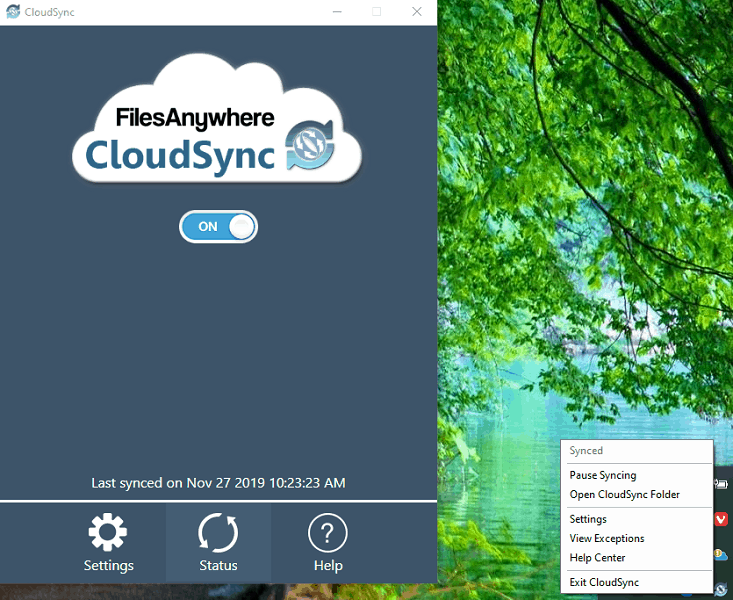
The desktop client uses the standard model of sync — a sync folder and a system tray icon — but the icon doesn’t show your recent files and other useful information in a neat pop-up window like some other EFSS services do.
In fact, the desktop client doesn’t do much at all. Short of creating a folder on your computer and asking if you want to include local folders, the application is no more than an “on” switch. Even the settings menu is bare, allowing you to choose what folders you include and to logout, but nothing else.
File Storage Sync Status
This system tray icon opens a window that shows your sync status and lets you access the settings. It’s clear and easy to use, but the sync status window, which lets you turn off sync, could be combined with the settings window to make it simpler. That said, we like how the sync folder enriches the files with icon badges that show their sync status.
The web client is a different beast. Depending on whether you log in as an admin or a standard user, you get access to the admin client or the user client. If you log in as a user, you can use the advanced interface or the new, streamlined interface, which provides fewer options.
We expected that the “sign in” button on the FilesAnywhere website would allow us to choose between the admin and user interface, but it doesn’t. Users can log in on the site, but admins have to use a custom URL. Even more confusing, users need a client ID to log in, which FilesAnywhere only provides in the welcome email.
The fact that FilesAnywhere forces users and admins to use different UIs is already bad. The fact that those two interfaces require different URLs and different sets of credentials is worse.
Interface: Admin vs Default
For admins, the interface feels modern and attractive. The buttons at the top let you access users, groups, divisions, reports, security settings and site configuration. Plus, you can quickly create users, groups and divisions using the buttons in the left sidebar. The right sidebar provides your account info, summary and a list of announcements.
The downsides are that the admin console is a bit slow and some of the operations need more steps than necessary. For example, when adding groups for users, you need to type the name of the group, click the search button, select it from a new view, click “save” and then add a group in on a separate page.
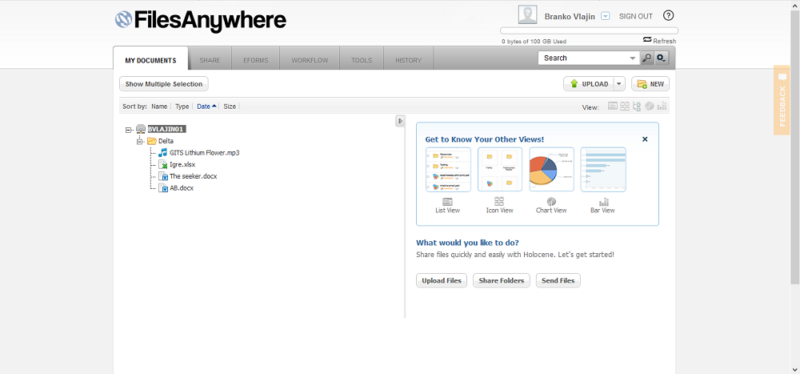
The default interface for standard users looks old and unattractive, but it is functional and has many options. The top menu has tabs that you can use to navigate the client and a search bar that looks for files as you type. The search is powerful because it provides many options that you can tweak and even lets you search for text in your files.
FilesAnywhere Views
The default view of the client is “my documents,” which shows your files in a tree view, but “list,” “icon,” “bar” and “graph” views are also available. You can perform actions by right-clicking a file or folder from the view.
To select multiple objects, though, you have to reload the entire view. This view also lets you upload content via drag-and-drop or through a window. You can tweak your account from the upper-right corner or access the Lite interface.
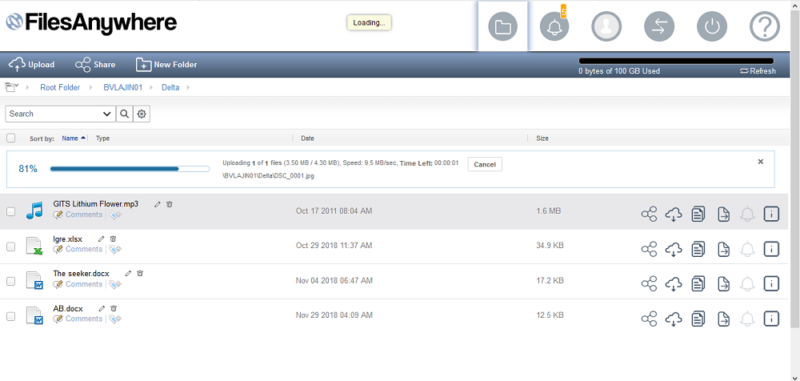
The Lite interface is streamlined, uses plenty of negative space, has a decent color scheme, provides in-line action buttons and has the ability to select multiple files without reloading the view. However, its search feature couldn’t locate a newly uploaded file, and the used storage bar doesn’t show how much you’re currently using if you don’t manually refresh it.
In addition, performing actions on individual files and folders opens a new window near the bottom of the page. The window is clunky, and part of it is obscured by white space. There’s a mobile client, too, but we couldn’t log in to it using our credentials, which means it’s unusable at the moment.
User Management
FilesAnywhere has capable user-management functionality, which includes generating reports, setting one of several permissions for users and creating groups and divisions of users. As the admin, you can also clone and impersonate users, which are good options if you want to check what they’re up to.
You can manage users by using the admin console, which lets you create users, groups and divisions. Divisions let you separate users to prevent unauthorized sharing of data as well as improve searching through users and their classification.
Groups let you specify a collection of permissions and a list of users that correspond to them. That makes it easier to assign a set of permissions to new users or to revoke that set from existing users by removing them from the group.
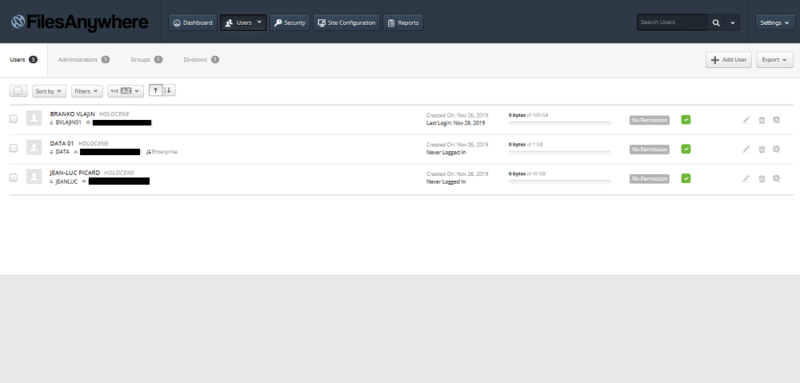
To do that, though, first you need to create some users. To add users, click the “add user” button and specify the necessary information. Besides the standard user info, you can specify a user’s division, manager, file storage space, folder sharing permissions, group affiliation and notes about the user.
In addition, you can tweak the user’s interface, enable or disable specific third-party plugins, disable the desktop client and enable two-factor authentication (2FA). We’ll talk more about 2FA in the next section.
FilesAnywhere Permissions
When you create users, you define which shared folders they can access and with what permissions. FilesAnywhere lets you set one of six permission levels:
- Master access: The user can add, modify and delete shared data, also share it with other users.
- Full access: The user can modify & delete shared data.
- Create & update: The user can modify or add data, but can’t delete.
- Read only: The user can’t modify or delete.
- Preview only: The user can only preview.
- Upload only: The user can only upload.
By default, these user permissions are set to never expire. However, you can specify them to do so after 24 hours or a year.
When creating a division, you can specify its name, code, sharing permissions and the maximum number of users that are allocated space. In addition, you can provide office contact information for the person that manages that division and define the division administrators. Combining all these features enables you to fine-tune what your users can do.
On top of this, there are options to clone a user and to impersonate them. This list of options isn’t exhaustive, but there isn’t an option to add users in bulk, such as from a CSV file. The only thing you can do to speed up adding users is to hit a button that enables you to immediately add another user after the first.
There’s also no option to add users as external collaborators, which would save you a license slot but still allow you to work with people outside of your organization.
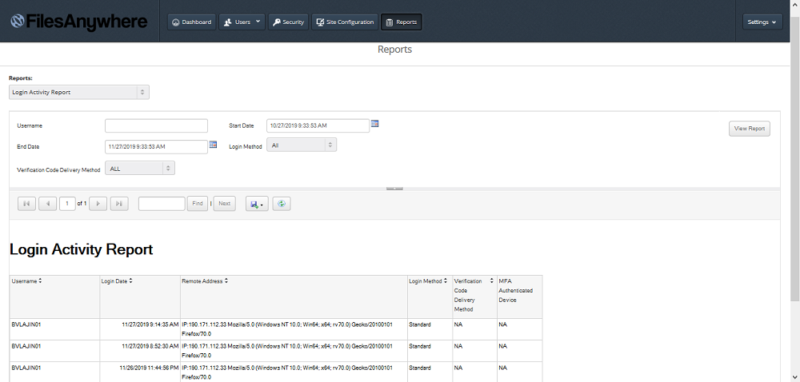
If you want to get a general overview of the various aspects of your account, you can generate one of 20 available reports, including “folder content,” “account summary,” “user data” and “file upload” reports. You can also get a brief summary and account info from the admin dashboard.
Security & Privacy
FilesAnywhere provides sufficient cloud storage protection features, but there’s no option to enable private encryption or remotely wipe files from your devices. That said, strong encryption is available, as well as features that protect your login credentials. On top of that, FileAnywhere’s data centers don’t skimp on security measures and comply with all the necessary protocols.
Data is protected during transit using a SSL/TLS channel, which uses AES-256 in most cases. Once your file reaches a server, they are secured using AES 256-bit encryption. If you use the CoolBackup feature, it will also locally encrypt your files using AES 256-bit.
It’s worth reiterating here, once again, that this encryption only applies to the top two plans. Business Starter users don’t have access to encryption.
Private encryption isn’t an option, which would block anyone but you from reading your files. Still, that’s the trend with EFSS services.
FilesAnywhere Access Controls
However, FilesAnywhere restricts access to your files to only a select number of technicians. The technicians are not permitted to access users’ documents unless required by law. Plus, they are bound by confidentiality agreements to respect your privacy.
Besides encrypting files, you need to secure your credentials by making sure your users don’t create weak passwords, but instead strong ones. You can do that by defining the minimum password strength and length from the admin console.
In addition, you can restrict whether passwords can be reused, set a limit of logins per day, restrict logging in from specific IP addresses and define the minimum and maximum age of the password. You can also instruct FilesAnywhere to automatically log users out to protect your account from any third-party tampering.
Plus, you can turn on two-factor authentication, which requires users to enter an additional code when logging in from an unfamiliar device. Subscribers to Professional and On Premise also get access to SSO.
Data Center Security
Once your files land in FileAnywhere’s data center, a wealth of features will protect them. First off, the data center is SOC-2 verified and McAfee Secure tested. The facility also provides fire suppression, power redundancy, heating, ventilation and air conditioning.
In addition, there’s 24/7 surveillance and a dedicated infrastructure team that works on-site to ensure any incidents or upgrades are performed as quickly as possible. However, if a failure happens, FilesAnywhere relies on N+2 redundancy to prevent single-point failures from affecting the rest of the data center.
FilesAnywhere also uses automatic online backup, daily snapshots of user accounts and data restore to make sure you don’t lose your information. On top of that, redundant backbone connections enable you to enjoy the highest levels of connectivity, regardless of any possible network issues.
The data center also complies with HIPAA, ISO 27001, SSAE16, FINRA and other protocols. Overall, these features make for strong data center security.
However, there’s no way to remotely wipe the data from your computers; you can do it only for mobile devices. Still, it’s useful if any of your users lose their phone or someone steals it.
Service & Support
If you don’t know how to do something using FilesAnywhere or if you encounter a problem, the fastest solution is to open the support center. You can do that using the menus in the top-right corner of the admin and user consoles, where you can also find email support.
The knowledgebase is dense in feature guides but lacking when it comes to troubleshooting. There are, as of late 2020, four total troubleshooting guides. In addition, there are a few other slim categories, including “mobile apps” and “backup and sync,” both of which have 12 articles apiece.
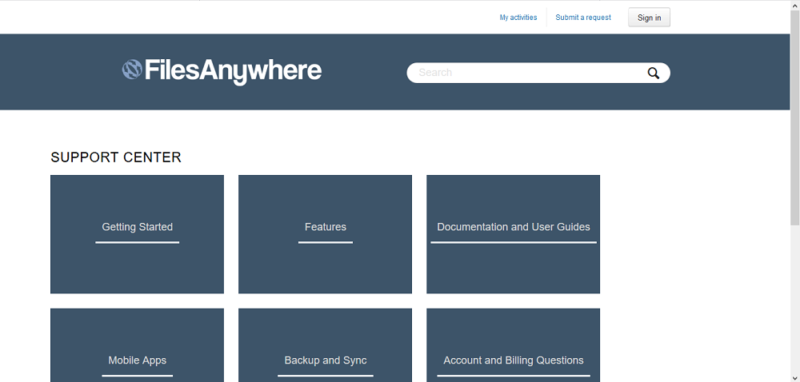
As far as the articles themselves, they’re not great. The knowledgebase combines general information articles — such as what SSO integrations are supported — with guides and setup information, making navigation confusing. On top of that, most articles are purely informational, with either one or two sentences per paragraph and little in the way of explanation.
For a consumer-facing file storage provider, this would be fine, if not ideal. Other enterprise-focused cloud storage providers, however, usually provide a wealth of onboarding and setup resources. This is true even of services that miss the mark overall, such as Citrix ShareFile (read our Citrix ShareFile review).
FilesAnywhere Direct Support
You can contact the support team via email or telephone Monday through Friday during the working hours of 7 a.m. to 7 p.m. CST. On Premise users enjoy 24/7 support in case of emergencies. We sent several emails, and a couple received prompt responses.
There’s no chat support, though, and its addition would be useful for users who prefer to type. Also, there are no community forums, which would enable you to get a possible solution from multiple users.
FilesAnywhere satisfies the bare minimum in some customer service areas, and in others, it misses the mark entirely. Email is the standout route if you can get your message in during active hours. Self-help resources also exist, but they’re far below what we’d expect from a service aimed at businesses.
The Verdict
For as much as FilesAnywhere gets right, it gets equally as much wrong. Although the price is decent, the most inexpensive tier is basically a non-option. The security is tight, but not all users have access to it. Lastly, customer service options are robust, but most of them fall behind the competition.
It’s the sharing and user-management functionality that stand out most. Folder sharing is a breeze, and there’s granular control over user management. Still, there are other cloud storage options that can match FilesAnywhere here while exceeding it in other areas.
What did you think of this FilesAnywhere review? Are you going to sign up for a trial? Let us know in the comments below and, as always, thanks for reading.
FAQ
No, there isn’t a free FilesAnywhere account. It’s a business-focused provider with plans starting at $4.49 per user when billed annually.
There are many good alternatives to FilesAnywhere, including Box, Dropbox, pCloud and Sync.com.
FilesAnywhere provides AES-256 encryption for data at rest and secures files in transit with a SSL/TLS channel. This is the industry standard for nearly all cloud storage providers, but FilesAnywhere offers encryption only for its two most expensive tiers. Its cheapest plan lacks encryption.



